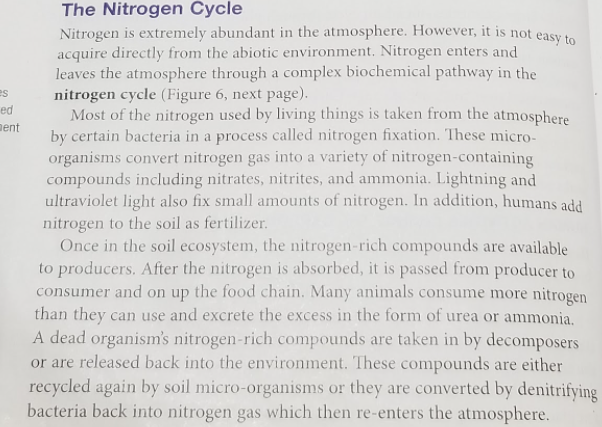Biology 2e
2nd Edition
ISBN:9781947172517
Author:Matthew Douglas, Jung Choi, Mary Ann Clark
Publisher:Matthew Douglas, Jung Choi, Mary Ann Clark
Chapter46: Ecosystems
Section: Chapter Questions
Problem 3VCQ: Figure 46.17 Which of the following statements about the nitrogen cycle is false? Ammonification...
Related questions
Question
In points, summarize the nitrogen cycle attached below.

Transcribed Image Text:The Nitrogen Cycle
Nitrogen is extremely abundant in the atmosphere. However, it is not easy to
acquire directly from the abiotic environment. Nitrogen enters and
leaves the atmosphere through a complex biochemical pathway in the
nitrogen cycle (Figure 6, next page).
es
ed
Most of the nitrogen used by living things is taken from the atmosphere
Dent
by certain bacteria in a process called nitrogen fixation. These micro-
organisms convert nitrogen gas into a variety of nitrogen-containing
compounds including nitrates, nitrites, and ammonia. Lightning and
ultraviolet light also fix small amounts of nitrogen. In addition, humans add
nitrogen to the soil as fertilizer.
Once in the soil ecosystem, the nitrogen-rich compounds are available
to producers. After the nitrogen is albsorbed, it is passed from producer to
consumer and on up the food chain. Many animals consume more nitrogen
than they can use and excrete the excess in the form of urea or ammonia.
A dead organism's nitrogen-rich compounds are taken in by decomposers
or are released back into the environment. These compounds are either
recycled again by soil micro-organisms or they are converted by denitrifying
bacteria back into nitrogen gas which then re-enters the atmosphere.
Expert Solution
This question has been solved!
Explore an expertly crafted, step-by-step solution for a thorough understanding of key concepts.
Step by step
Solved in 2 steps

Knowledge Booster
Learn more about
Need a deep-dive on the concept behind this application? Look no further. Learn more about this topic, biology and related others by exploring similar questions and additional content below.Recommended textbooks for you

Biology 2e
Biology
ISBN:
9781947172517
Author:
Matthew Douglas, Jung Choi, Mary Ann Clark
Publisher:
OpenStax

Biology: The Unity and Diversity of Life (MindTap…
Biology
ISBN:
9781337408332
Author:
Cecie Starr, Ralph Taggart, Christine Evers, Lisa Starr
Publisher:
Cengage Learning

Concepts of Biology
Biology
ISBN:
9781938168116
Author:
Samantha Fowler, Rebecca Roush, James Wise
Publisher:
OpenStax College

Biology 2e
Biology
ISBN:
9781947172517
Author:
Matthew Douglas, Jung Choi, Mary Ann Clark
Publisher:
OpenStax

Biology: The Unity and Diversity of Life (MindTap…
Biology
ISBN:
9781337408332
Author:
Cecie Starr, Ralph Taggart, Christine Evers, Lisa Starr
Publisher:
Cengage Learning

Concepts of Biology
Biology
ISBN:
9781938168116
Author:
Samantha Fowler, Rebecca Roush, James Wise
Publisher:
OpenStax College


Biochemistry
Biochemistry
ISBN:
9781305577206
Author:
Reginald H. Garrett, Charles M. Grisham
Publisher:
Cengage Learning
